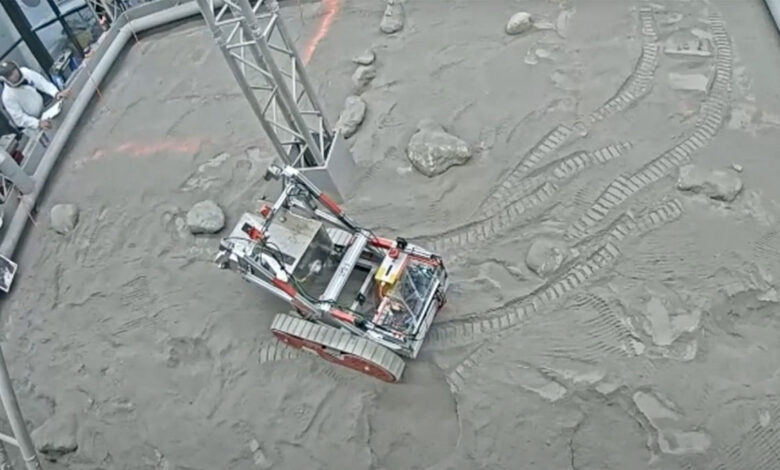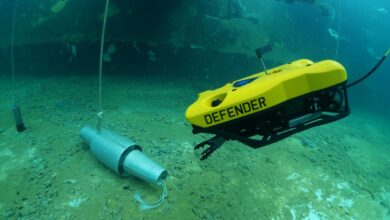U Robotics Team receives bronze at national competition – @theU

The team poses with their robot, ELE.
The Utah Student Robotics club returned last week from NASA’s Kennedy Space Center with awards in tow after a strong showing in the space agency’s competition for designing rovers that can move material on the moon.
The team from the University of Utah’s John and Marcia Price College of Engineering started the Lunabotics Challenge in a field of 58 and made it to a qualifying event held at the Florida Space Institute’s Exolith Lab alongside 41 other teams. Placing second, the U students advanced to the finals at Kennedy Space Center.
There, they finished third in three categories: the Presentations and Demonstrations Award, the Caterpillar Autonomy Award, and the Robotic Construction Award.
Teams were tasked with designing a rover capable of building a berm structure — essentially, a protective embankment— from regolith, the layer of rocky debris that blankets the lunar surface. Such berms could be a key feature of an extended human presence on the moon, defending against ejecta during lunar landings and launches, shading cryogenic propellant tank farms, shielding a nuclear power plant from space radiation, among other uses.
“The task of robotically building berm structures will be important for preparation and support of crewed lunar missions,” said Kurt Leucht, NASA software developer and In-Situ Resource Utilization (ISRU) researcher, as well as longtime Lunabotics commentator. “These competing teams are not only building critical engineering skills that will assist their future careers, they are literally helping NASA prepare for our future Artemis missions to the Moon.”
In the finals, the U Team worked alongside their bulldozer-shaped robot within the competition arena’s simulated lunar environment. While in the arena, team members wore full-body protective gear consisting of bunny suits and N-95 masks, including helmets with respirators. This wasn’t just to complete the lunar look — BP-1, NASA’s regolith simulant, is made of fine silica particles which pose a lung-damaging biohazard. Protecting the robot from regolith’s corrosive qualities was also part of the challenge; before suiting up, the team had to demonstrate their acumen in a variety of technical and organizational categories.
After placing their robot in the arena, the U team had 30 minutes to pilot through an obstacle field and move simulated regolith between excavation and construction zones. Teams scored points for every cubic meter of berm structure they built, but to emphasize efficient designs were penalized based on their robot mass, power, and bandwidth usage.
“Despite losing points, our team approached the competition with a ‘go big or go home strategy,’” says Andrew Tolton, the team’s systems engineering lead and vice president of the Utah Robotics club. “We brought the heaviest robot out of any team, and used it to build the biggest berm.”
The team could also signal to judges that they were about to take their hands off of the robot’s controls, receiving additional points when their robot autonomously performed certain maneuvers.
After the competition, NASA totaled up the points for each of these categories, with Utah Student Robotics placing 3rd in the Robot Construction category.
“We had many deliverables besides our robot berm construction performance,” says Tolton, “including making a project management plan, doing STEM outreach with kids in the community, writing a Systems Engineering paper, and giving NASA a presentation about our robot.”
These other deliverables incentivize the Lunabotics teams to learn effective systems engineering and product management strategies, were both these deliverables and the Robot Construction score are used to award the Grand Prize.
Coordinated by NASA’s Office of STEM Engagement, Lunabotics has taken place annually since 2010. As one of NASA’s Artemis Student Challenges, the competition is designed to engage and retain students in STEM fields within the context of the agency’s moon exploration missions.
The U Team began competing in the Lunabotics Challenge in 2016. They took home second place in the Systems Engineering paper award in last year’s competition. Another U team won the Artemis Lunar Forge Challenge earlier this year.
This year’s Lunabotics team consisted of Chandler Millar, Andrew Tolton, Daniel Robinson, Najman Husaini, Nathaniel Bruns, Brycen Cheney, Jacob Wilson, Samuel Friel, Wyatt Jones, Joseph Youngblood, Leah Smock, Anthony Bolda, Vincent Banh, Carlos Carvajal, Ethan Larsen, and Kwinten Hale.



